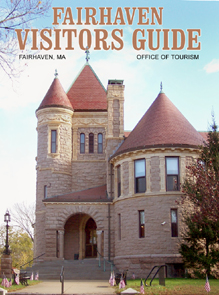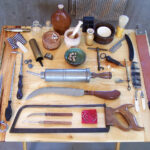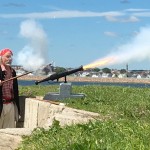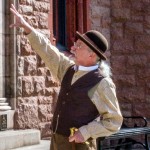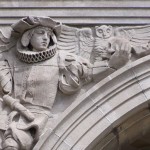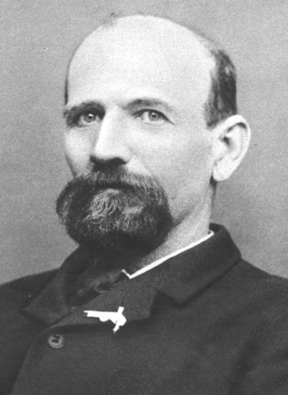
First man to sail alone
around the world
On July 3, 1898, a few days after Capt. Joshua Slocum completed his three-year solo circumnavigation of the world in his small sloop Spray, he sailed the 36-foot craft up the Acushnet River to a place on the shore of the “Poverty Point” neighborhood of Fairhaven. There he tied up to a cedar post that had held the Spray when Slocum had first launched her several years earlier. “I could bring her no nearer home,” the captain wrote. For close to that spot, Slocum had resurrected the old vessel which ultimately became the first craft to be sailed around the world single-handedly.
Joshua Slocum, born in Nova Scotia in 1844, was a “celebrated sailor and adventurer” whose fame came first following the publication of a book Voyage of the Liberdade. The book told of the shipwreck of Slocum’s ship Aquidneck and his building of the 35-foot Liberdade, in which he and his family sailed from Brazil back to America. Following the publication of the book, Slocum toured with the Liberdade, visiting Harris’ boat stage near the foot of Washington Street in Fairhaven in August of 1890. It was at this time that Slocum met Capt. Eben Pierce, a retired seaman who resided at Poverty Point. Capt. Pierce was an uncle of Slocum’s friend Capt. John Drew, a marine writer who may have inspired Slocum to publish the stories of his own voyages.
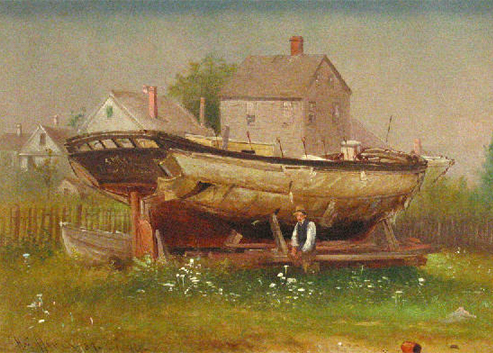
In a field on the waterfront near the captain’s home, Pierce kept his old sloop Spray, which had fallen into disrepair after a long life. His intention of repairing the vessel for use as a fishing smack had never been carried out. Slocum, bored with monotonous shipyard work, decided to rebuild the Spray and live aboard her.
In November 1891, headlines in the New Bedford Republican Standard read:
“A FLOATING HOME
–––––
Builder of La Liberdade at Work
On the Spray.
–––––
To Be Made a Cruiser and Pleasure
Boat for Southern Waters.
–––––
Stories of Adventure from the Life of
Capt. Joshua Slocum”
Writing later in Century Magazine and Sailing Alone Around the World, Slocum would spin this tale of his coming to Fairhaven somewhat differently for dramatic effect.
The Spray, while Slocum rebuilt it, was located on a lot of land owned by Eben Pierce which ran between Lafayette Street and what’s now Pilgrim Avenue. It was just east of the park where a Slocum monument now stands. Capt. Pierce’s boathouse stood toward the north end of the narrow lot.

Slocum spent several months completely rebuilding the Spray board by board. In the Republican Standard article by Grace Parker, cited previously, he related how he planned to sail in southern waters to collect specimens of foreign sea life in an aquarium he would install on the deck of the Spray. He had not yet decided whether he would rig the vessel as a sloop or a schooner. There was nothing in the story to indicate that Slocum had any intention at that time of sailing the Spray around the world.
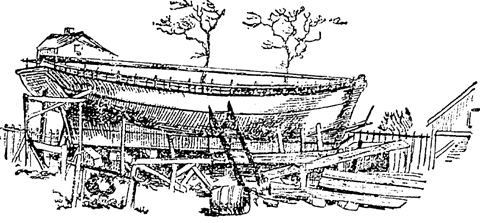
On June 22, 1892, the New Bedford Evening Journal announced, “Sloop yacht Spray, built by Capt. Slocum of La Liberdade fame, was launched yesterday afternoon from the shore at Oxford village, Fairhaven.” The Spray’s first voyage took place July 16, with Slocum taking a party to Onset. The following week the Spray served as the judges’ boat for the New Bedford Canoe Club’s regatta on the Acushnet River. After its launch, Slocum started living aboard the Spray, and his “floating home” was used to entertain guests during that summer.
The next year Slocum spent fishing. His invention of the “Spray spring net” for catching mackerel was described in a newspaper story published in the fall. Shortly afterward, the captain, in need of money, agreed to transport the warship Destroyer from New York to Brazil. That occupied his time from December 1893 until March 1894, when he returned to his home aboard the Spray to write a small booklet about that most recent voyage.
In 1894, Slocum moved the Spray to Boston where he continued to fish until winter.
Then, on April 24, 1895, Capt. Slocum set out on what would become a three-year, 46,000 mile journey around the globe. This feat is legendary in sailing lore. The classic sea tale has inspired many others to duplicate his journey. It would be more than 25 years before another, Harry Pidgeon, sailed a solo circumnavigation, but Pidgeon used the Panama Canal, while Slocum sailed the treacherous Straits of Magellan. The first solo circumnavigation to follow Slocum’s route was completed in 1938 by Louis Bernicott of France.
Slocum’s solo voyage ended on June 27, 1898, at Newport, RI. Less than a week after the journey’s end, the captain sailed the Spray up the Acushnet River to Poverty Point where he had first launched the little vessel.
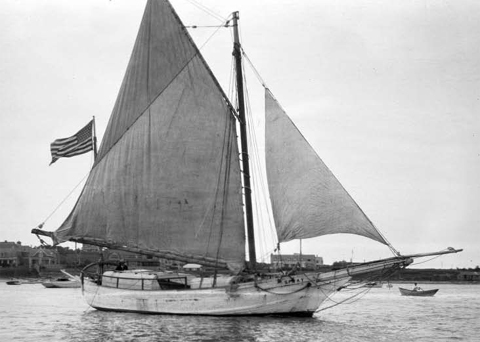
Capt. Joshua Slocum and the Spray were lost at sea after the captain set sail in November 1908.
On Saturday, September 11, 1909, the Fairhaven Star published a short notice headed, “CAPTAIN SLOCUM LOST?” The newspaper reported, “It is feared that Captain Joshua Slocum of West Tisbury, formerly of Fairhaven, owner of the famous yawl Spray, in which the noted lecturer and sailor has circumnavigated the globe, has been lost at sea in the little 33-foot craft, the smallest boat that ever sailed around the world. The return of Captain Slocum’s mail unopened, from a foreign port to which he directed it to be sent when he sailed from this port last November on one of his long cruises on the Spray, and the fact that no word has been received from him since he sailed, has led his wife and relatives to believe that he has been lost.” On July 30, 1910, the Star printed an update saying nothing had been heard from the captain in twenty months, and “his family has given up all hope of ever hearing from him again.” He was not officially declared dead until the early 1920s.
On April 18, 1959, the town of Fairhaven dedicated a commemorative bronze plaque on a boulder in a park on Pilgrim Avenue close to where Slocum had launched the Spray. The principal speaker at the ceremony was Slocum’s biographer William Magnes Teller. In 1995 and 1998, Fairhaven held centennial celebrations honoring the beginning and the end of Slocum’s around-the-world voyage.
Click on the links to see places associated with Joshua Slocum.
Capt. Joshua Slocum Monument (1958)
Capt. Ebenezer Pierce House (ca. 1815)
SOURCES:
Fairhaven Star, articles published 1890-1911.
Grayson, Stan, A Man for All Oceans, Tilbury House Publishing, Thomaston, ME and New Bedford Whaling Museum, New Bedford, MA, 2017
New Bedford and Fairhaven Directory, W.A. Greenough & Co., pubishers, Boston, MA, 1892
New Bedford Evening Journal, June 22, 1892.
New Bedford Republican Standard, articles published 1890-1898.
Slocum, Joshua, letter to Century Magazine editor Clarence Clough Buel, May 13, 1902, about first meeting Eben Pierce in New Bedford.
Slocum, Joshua, Sailing Alone Around the World, 1900, Century Company, NY
Special thanks to Robert Birely for his historical research and to Melville Brown for a copy of Slocum’s 1902 letter.

